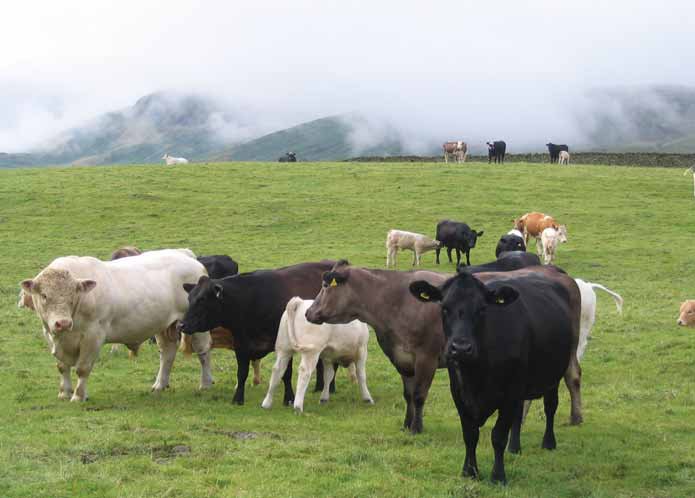Cattle breeding, Azerbaijan’s agricultural frontier

By Gulgiz Dadashova
Azerbaijan yearns for an economy driven by the non-oil sector, but not petrodollars. That means putting more effort to develop local production and more support to agriculture, one of Azerbaijan’s best non-oil sector development options.
As the global energy sector still shows volatility, Azerbaijan is betting on agriculture. The country has already seen a 9.2 increase in the non oil-sector, and a 7.3 percent rise in agriculture in the first half of 2015.
Animal breeding is of crucial importance for restoring and protecting the country's food security, and it has already achieved positive results. Azerbaijan ranks the 58th among 109 countries of the world according to the Global Food Security Index 2015. It has improved its score by 7 points from its 2014 ranking. This year, Azerbaijan stands 10th among Asia and Pacific countries.
State care
A case for government involvement in any industry, whether banking or agriculture, is made by pointing to the appearance of strong entrepreneurs as a result. The main driver in every sector is the emergence of owners of small and medium sized businesses that understand local economic models better than foreign investors and are eager to grow together with the economy.
In accordance with the recent executive orders, cattle breeding industry of the agriculture sector will gain a big boost from the state.
The President’s Reserve Fund will allocate 15 million manats (over $14.3 million) for the development of cattle breeding in the country.
The funds will be directed to cattle imports, breeding pedigree cattle, and their sale by agricultural producers, who are engaged in animal breeding with a 50 percent privilege by leasing.
An order was given by President Aliyev to strengthen state support to improve cattle pedigree, as well as improve the domestic demand of livestock products, and raise livestock with highly productive genetic potential.
The order also increases subsidies to livestock owners for each bull produced by artificial insemination to the tune of 100 manats ($95).
In yet another order, 5.8 million manat (over $5.5 million) will be allocated from the Reserve Fund to increase the production of animal products, improve the cattle breeding, and to accelerate the artificial insemination and preservation of local breeds of pedigree horses. Of this, 2.8 million manat will be directed to reconstruction of the Republican Center for artificial insemination, 1.5 million manat to complete the development measures to breed Karabakh horses, and 1.5 million manat to breed Dilbazi horses.
While more money spent on agriculture means greater food security at home, it is also necessary to ensure access to export markets. Fewer markets may limit the development of agriculture.
To enter export markets, products should be competitive and better logistical capabilities should be ensured.
Following the traditions
The presidential orders cover very important issues that will be a milestone for the development of livestock, said Galib Abdulaliyev, the head of Agriculture Ministry’s Department for Livestock Development.
“To ensure the demand in animal production, first there is a need to breed livestock with high genetic productivity. The resolution and allocated funds will allow [us] to solve the problems in this regard,” Abdulaliyev wrote in an e-mail to AzerNews.
Livestock production occupies second place in the agriculture development in the country. Cattle are very important for meat and milk in regions of Azerbaijan, as all farmers keep at least one or two cows for subsistence dairy products, while richer farmers own more. In regions, many earn living by selling live animals, meat, milk, and dairy products.
All small ruminants are owned by villagers. Most of the farmers keep 15-20 or more sheep. Large owners keep 200-500 and employ either a shepherd or family members take the sheep for grazing. Sheep are predominant, while goats make up only 1-2 percent of flocks. In some villages, especially in the mountains, small ruminants are herded in joint village flocks.
Pastures and meadows satisfy two-thirds of total fodder requirement of livestock and are the cheapest fodder base in the republic, according to FAO.
Abdulaliyev further spoke about the important aspects of providing long-lasting development.
He notes that three steps need to be taken in this regard: cattle and small ruminants need to have high genetic productivity, demand for fodder should be met, and they must be protected against diseases. “Currently, we focus our attention on these aspects,” he added.
Assuring that the country has a potential to fully ensure demand in this sector and even export some of the products, Abdulaliyev said the goal is to expand application of modern technologies in the development of livestock.
“Lowland and foothill areas of the country are better for the development of dairy cattle breeding, while the mountainous regions are more favorable for cattle for slaughter. Taking into account regional specifics and the effective use of natural resources, sheep and cattle breeding can be developed successfully,” he said.
During these seven months of 2015, livestock grew by 2.4 percent, meat production by 1.8 percent, milk by 3.7 percent, eggs by 1 percent, and wool by 1.8 percent.
Following the agrarian reforms, the number of horned cattle and small ruminants began to increase due to privatization and a transition to a market economy. The number of cattle was only 925,800 in 2010, while the figure hit 1.3 million as of January 2015. The number of small ruminants was 5,774 million and the figure hit over 8,645 million as of January 2015.
--
Follow Gulgiz Dadashova on Twitter: @GulgizD
Follow us on Twitter @AzerNewsAz
Here we are to serve you with news right now. It does not cost much, but worth your attention.
Choose to support open, independent, quality journalism and subscribe on a monthly basis.
By subscribing to our online newspaper, you can have full digital access to all news, analysis, and much more.
You can also follow AzerNEWS on Twitter @AzerNewsAz or Facebook @AzerNewsNewspaper
Thank you!
